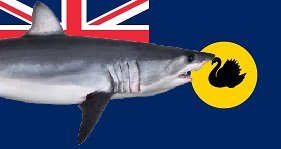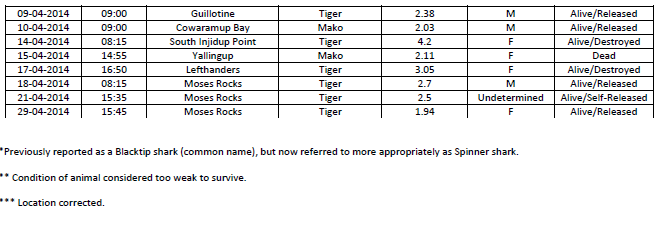WA: 172 Sharks caught on drumlines, 50 killed
 Media Release
Media Release
Department of Fisheries, Western Australia
07. May 2014
——————–
Figures support shark mitigation strategy
- $22million Shark Hazard Mitigation Program continues to inform beachgoers and builds on research base
- 172 sharks caught, 90 new sharks tagged, two with internal acoustic tags
- Fewer beach closures due to shark sightings in 2013-14
The State Government’s shark mitigation policy is successfully restoring confidence among Western Australian beachgoers and greatly contributing to the scientific knowledge about shark behaviour, Fisheries Minister Ken Baston said today.
In addition to the ongoing monitoring and researching of sharks and the continued partnership with Surf Life Saving WA for aerial and beach surveillance, he said the added protection of drum lines had gone some way to restoring confidence among swimmers, surfers and divers using Perth and South-West beaches.
Mr Baston said the drumline program had proved effective in complementing the other strategies.
“The drumline program is just one facet of the State Government’s $22million Shark Hazard Mitigation Policy which also includes aerial and jet ski patrols, rapid response initiatives, tagging and research, the Sharksmart website and the Surf Life Saving twitter feed,” he said.
Thirty drum lines were removed from Perth’s main beaches on April 30 and the same number from the South-West.
A total of 172 sharks were caught on the lines – 111 of them off the metropolitan coast – and 90 sharks were tagged before being released.
No previously tagged sharks were caught and 90 new sharks were tagged in drumline operations.
Fifty sharks larger than three metres were destroyed, including five over four metres. Another 95 caught were bigger than two metres.
The largest shark was caught in February at popular Floreat Beach and measured 4.5m.
“The human toll from shark attacks in recent years has been too high,” the Minister said.
“Our carefully implemented policy targeted the most dangerous shark species known to be in our waters – white, tiger and bull sharks.
“While of course we will never know if any of the sharks caught would have harmed a person, this Government will always place greatest value on human life and I am pleased that these measures working in tandem with our research have gone some way to restoring confidence among beachgoers.
“Our beaches are some of the best in the world and I want future generations and visitors to WA to be able to enjoy them without the constant fear of shark attack.”
Mr Baston said the data collected in the drumline operation would complement existing and new research into shark movements in Western Australian waters.
“We continue to learn more about when and where dangerous sharks are prevalent,” he said.
“This will help researchers who are exploring shark hazard mitigation alternatives.”
Figures also show there were fewer beach closures in 2013-14 due to shark sightings, down from 131 closures in 2012-13 to 93 in 2013-14.
“I think the lower number of beach closures negates the fanciful arguments that the drum lines bring large sharks closer to shore,” the Minister said. “At this point, it seems they do the opposite.”
The strategic hook design and daily monitoring of the drum lines has meant only eight marine animals were caught as by-catch, including a north-west blowfish and stingrays.
No marine mammals were caught.
Fact File
- The Westpac helicopter aerial patrols performed 425 targeted hours of patrols in the metropolitan area this season, down from 488 hours in 2012-13. The patrols also flew 278 hours in the South-West, up from 263 hours the previous year
- The aerial patrols sighted 126 sharks along Perth beaches (123 in 2012-13) and 117 in the South-West (162 the previous summer)
- The Surf Life Saving WA Twitter feed published 869 tweets in relation to sharks in WA from December 2, 2013, to April 26, 2014
- The State Government has committed $2m to shark research with preliminary laboratory and field testing indicating some novel and existing deterrents are effective in repelling sharks. For example, algorithms have been developed that can automatically detect and distinguish between large marine animals and surfers, swimmers and boats in videos, and results from sonar detection of sharks and shark-like objects (both captive and wild) are promising, but significant work is still required
Source: Department of Fisheries WA
Catch data for shark drum line deployment 25 Jan 14 to 30 Apr 14







Has it ever been tried to throw some dead sharks close to the beaches? It seems those feromones shy away most sharks